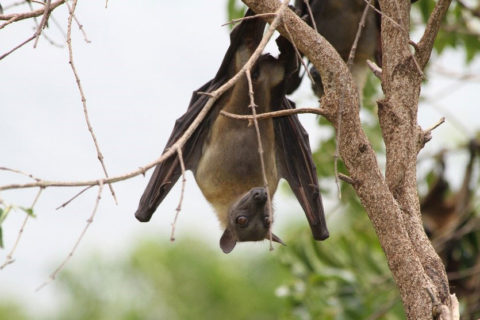How You and the Zoo are Helping to Save Bats in Rwanda
-
-
Education campaign at a Primary School near one of the bat colonies being observed by RWCA. Photo credit: RWCA
-
Team members set seed traps to test bat droppings. Photo credit: RWCA
-
RWCA team member asking students studying nearby questions regarding bats. Photo credit: RWCA
-
African straw-colored fruit bat. Photo credit: RWCA
When we last caught up with Houston Zoo partners Dr. Olivier Nsengimana and Marie Claire Dusabe, the Rwanda Wildlife Conservation Association (RWCA) had just started a new project to help save straw-colored fruit bats in Rwanda! As people all around the globe celebrate bat appreciation month and we prepare for Dr. Olivier’s visit to Houston at the end of this week, it seemed like the perfect time to share some exciting updates from the field.
Marie Claire, Bat Project Coordinator for RWCA, and her team have been hard at work trying to establish the important role that the African straw-colored fruit bat plays in Rwanda’s ecosystem. What is a straw-colored fruit bat, you ask? As you may have guessed, this species got its name from the yellowish or straw-colored fur on its body. It is also known as a mega-bat due to its large size – an individual bat can reach a length of 5-9 inches and can have up to a 2.5-foot-long wingspan! The Central African region, including Rwanda, is known to be home to about 60% of all Africa’s bat species, yet they are the least studied in comparison to other mammals – something the team at RWCA hopes to change.
Since February, the team has been travelling around Rwanda to 12 different locations to conduct monthly counts of straw-colored fruit bats. This data allows researchers to track changes to bat population numbers across the country, as well as make note of any major differences in the number of roosting sites (places where bats gather to rest) being utilized. Next year, the team will begin tagging select bats from each location with GPS units which will help them to better understand where bats go and what might cause movements from one area to the next. Team members have also spent time collecting bat droppings from colonies of straw-colored fruit bats to gain a better understanding of the role bats play in keeping the forest healthy through seed dispersal. Additional studies on insectivorous bats to find out what insects they are eating will also help the team demonstrate to communities just how beneficial bats can be, whether they are acting as accidental pollinators or controls for mosquitoes and agricultural pests.
While the data collection is invaluable to the project, community outreach is equally as important when it comes to saving these bats, which is why the team has been working with schools and community groups living in close proximity to bat colonies. 489 primary students participated in an RWCA workshop, spending time learning about the life, role, and importance of bats, and each class was given a copy of a “Bats of Rwanda” comic book. Students and community members were also asked to complete a short questionnaire which would allow the team to see people’s current perception of bats and whether or not they believe the species should be protected. Project support groups made up of locals have also been put in place. Participants will work with researchers to monitor bat colonies and perform basic data collection as well as protect any existing colonies from illegal activities.
Projects like this one take a great deal of dedication and collaboration and we are proud to support RWCA’s efforts to protect a species that is often feared and misunderstood. You can help us support this important wildlife saving work by visiting our colony of fruit bats on your next visit to the Zoo. See you soon!





